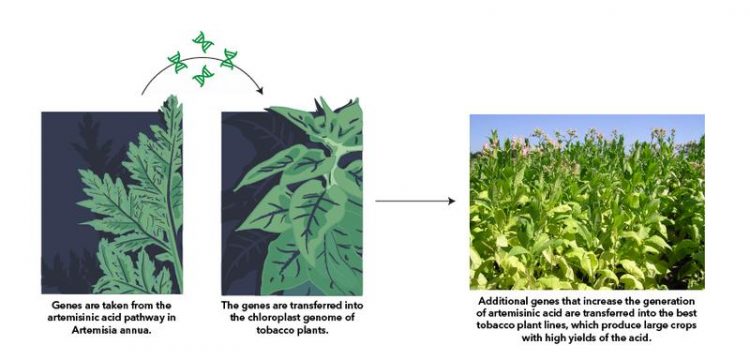New plant engineering method could help fill demand for crucial malaria drug

A new and inexpensive technique for mass-producing medical drugs.
Artemisinin is produced in low yields by a herb called Artemisia annua (A. annua), otherwise known as sweet wormwood. Researchers from the Max Planck Institute of Molecular Plant Physiology have now discovered a new way to produce artemisinic acid, the molecule from which artemisinin is derived, in high yields.
Their method involves transferring its metabolic pathway – the series of biochemical steps involved in its production – from A. annua into tobacco, a high-biomass crop.
“Malaria is a devastating tropical disease that kills almost half a million people every year,” says contributing author Ralph Bock, Director of the Department for Organelle Biology, Biotechnology and Molecular Ecophysiology.
“For the foreseeable future, artemisinin will be the most powerful weapon in the battle against malaria but, due to its extraction from low-yielding plants, it is currently too expensive to be widely accessible to patients in poorer countries. Producing artemisinic acid in a crop such as tobacco, which yields large amounts of leafy biomass, could provide a sustainable and inexpensive source of the drug, making it more readily available for those who need it most.”
The team has called this approach to producing more artemisinic acid COSTREL (“combinatorial supertransformation of transplastomic recipient lines”). The first step in their process was to transfer the genes of the artemisinic acid pathway’s core set of enzymes into the chloroplast genome of tobacco plants, generating what are known as transplastomic plants.
The team then used their best transplastomic tobacco plant line to introduce an additional set of genes into its nuclear genome, generating the COSTREL lines. These remaining genes encode factors that increase the synthesis, or generation, of the acid in ways that are still largely unknown.
“While the artemisinic acid pathway in A. annua is confined to the glandular hairs on the plant, leading to low yields of artemisinin, our COSTREL tobacco lines produce it in their chloroplasts and therefore the whole leaf,” says lead author and postdoctoral researcher Paulina Fuentes.
“We generated over 600 engineered tobacco plant lines that harbour different combinations of these additional genes, and analysed them in terms of the amounts of artemisinic compounds they acquired. We could then identify those that generated unprecedented levels of 120 milligrams per kilogram of artemisinic acid in their leaves, which can be readily converted into artemisinin through simple chemical reactions.”
Although further increases in these production levels will be needed if global demand for artemisinin is to be met, the study lays the foundation for much cheaper production of this life-saving therapy in a high-biomass crop, in contrast to a single medicinal plant.
It also provides a new tool for engineering many other complex pathways, with the potential to increase production of other essential therapeutic ingredients.
Reference
The paper ‘A new synthetic biology approach allows transfer of an entire metabolic pathway from a medicinal plant to a biomass crop’ can be freely accessed online at http://dx.doi.org/10.7554/eLife.13664. Contents, including text, figures, and data, are free to reuse under a CC BY 4.0 license.
Media contacts
Emily Packer, eLife
e.packer@elifesciences.org
01223 855373
Ulrike Glaubitz, Max Planck Institute of Molecular Plant Physiology
glaubitz@mpimp-golm.mpg.de
+49 331 567 8275
http://www.mpimp-golm.mpg.de/2069723/rbock-malaria-drug-in-tobacco
Media Contact
All latest news from the category: Agricultural and Forestry Science
Newest articles

A universal framework for spatial biology
SpatialData is a freely accessible tool to unify and integrate data from different omics technologies accounting for spatial information, which can provide holistic insights into health and disease. Biological processes…

How complex biological processes arise
A $20 million grant from the U.S. National Science Foundation (NSF) will support the establishment and operation of the National Synthesis Center for Emergence in the Molecular and Cellular Sciences (NCEMS) at…

Airborne single-photon lidar system achieves high-resolution 3D imaging
Compact, low-power system opens doors for photon-efficient drone and satellite-based environmental monitoring and mapping. Researchers have developed a compact and lightweight single-photon airborne lidar system that can acquire high-resolution 3D…





















